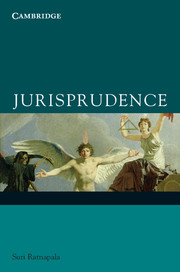Book contents
- Frontmatter
- Contents
- Acknowledgements
- List of Figures
- 1 Introduction
- PART 1 LAW AS IT IS
- PART 2 LAW AND MORALITY
- PART 3 SOCIAL DIMENSIONS OF LAW
- 7 Sociological Jurisprudence and Sociology of Law
- 8 Radical Jurisprudence: Challenges to Liberal Legal Theory
- 9 Economic Analysis of Law
- 10 Evolutionary Jurisprudence
- PART 4 RIGHTS AND JUSTICE
- References
- Index
10 - Evolutionary Jurisprudence
from PART 3 - SOCIAL DIMENSIONS OF LAW
- Frontmatter
- Contents
- Acknowledgements
- List of Figures
- 1 Introduction
- PART 1 LAW AS IT IS
- PART 2 LAW AND MORALITY
- PART 3 SOCIAL DIMENSIONS OF LAW
- 7 Sociological Jurisprudence and Sociology of Law
- 8 Radical Jurisprudence: Challenges to Liberal Legal Theory
- 9 Economic Analysis of Law
- 10 Evolutionary Jurisprudence
- PART 4 RIGHTS AND JUSTICE
- References
- Index
Summary
Like the winds, that come we know not whence, and blow withersoever they list, the forms of society are derived from an obscure and distant origin; they arise, long before the date of philosophy, from the instincts, not from the speculations, of men. The croud of mankind, are directed in their establishments and measures, by the circumstances in which they are placed; and seldom are turned from their way, to follow the plan of any single projector.
Adam Ferguson (1966 (1767), 122)Introduction
The second half of the 20th century witnessed a resurgence of evolutionary theory in both the natural sciences and the social sciences. The most significant feature of this movement has been the extension of the Darwinian theory of evolution – or, more accurately, the neo-Darwinian synthesis – to human culture in order to explain such phenomena as scientific and technological development, the emergence of formal and informal social institutions, language acquisition, and even mind and consciousness. Evolutionary accounts of legal emergence have figured prominently throughout the 20th century in cultural anthropology and within branches of economics, most notably the Austrian and the institutional economics traditions. Although American jurisprudence was quick to embrace evolution after Darwin, legal scholars in the 20th century have only paid sporadic attention to evolutionary accounts of law (Ruhl 1996a, 1412–13). The situation has changed somewhat with the persistent efforts in law and biology by scholars associated with the Gruter Institute for Law and Behavioral Research (Elliot 1997, 596) and the nascent complexity and law movement (Ruhl 1996a, 1996b).
- Type
- Chapter
- Information
- Jurisprudence , pp. 267 - 292Publisher: Cambridge University PressPrint publication year: 2009

